Novel data support model linking floral resources and honey bee competition with bumble bee abundances in coastal scrub
DOI:
https://doi.org/10.26786/1920-7603(2021)625Abstract
Growing evidence supports that many bee populations are declining, with potentially serious consequences for pollination services. Mechanistic models that predict bee abundances from drivers like floral resource availability can be a powerful way to understand and address declines, but remain rare and largely unvalidated. I used temporally and spatially novel data to validate previous analyses linking bumble bee (Bombus spp.) declines in California coastal scrub with loss of floral resources, mediated by drought and competition with non-native honey bees (Apis mellifera). New observations from 2015-2018 were combined with data from 1999-2014 to further test these mechanistic hypotheses and evaluate predictions of a statistical model for Bombus abundances. As predicted, positive associations between spring rainfall and floral abundances and between Bombus and key forage plants were consistent between time periods. Increased A. mellifera abundance corresponded with reduced Bombus use of the most abundant forage plant and lower Bombus abundances in the following year. Quantitative predictions from the Bombus statistical model previously developed for 1999-2014 were relatively unbiased and strongly rank correlated with either spatially or temporally novel data. However, the model consistently underpredicted Bombus abundances when both flower patch and time period were novel. Overall, four new years of data further strengthen evidence that loss of floral resources due to drought and competition with feral Apis mellifera is an important cause of Bombus decline in this habitat. These findings reinforce the value of even simple models that are mechanistically framed, both in understanding past patterns of change and for qualitative prediction.

Published
How to Cite
Issue
Section
License
Copyright (c) 2021 Diane M Thomson

This work is licensed under a Creative Commons Attribution 4.0 International License.











